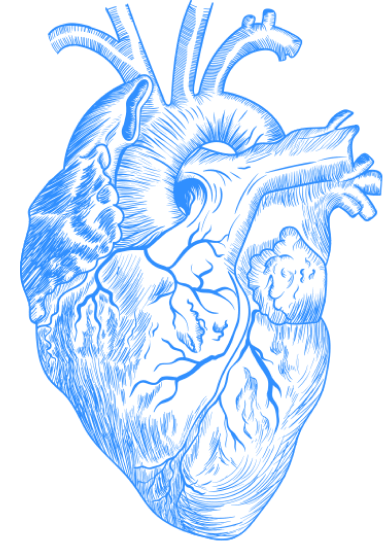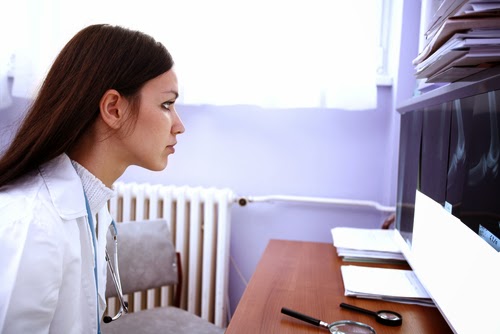
This post continues my description in the last one of a day in the life of a medical student on rotation, where I’ve left off at lunchtime of an inpatient service day.
During the afternoon, the work of executing plans continues. If the team discharges a patient, that patient needs a follow-up appointment in clinic to make sure there are no complications from the hospital visit. We call up the outpatient clinics and schedule patients for their next appointments. In other cases, we need a patient’s hospital records from his or her previous visit to another hospital. Because electronic health records are usually closed within a hospital system, we have to request that other hospitals fax us medical information. This is a rate-limiting factor in getting complete access to lab and imaging results, which are integral to patient care. For instance, if a patient comes in with a severe headache and another hospital performed a CT scan of his head, access to that scan may be essential to ruling out a diagnosis of something serious, like a brain tumor or infection. And if we can’t get the images from the other hospital we may have to do one at our hospital. This is, undoubtedly, one of the major weaknesses of a non-universal electronic health record system.
The medical team may also discharge a patient to a skilled nursing facility (SNF) or an old-age home, in which case the facility needs documentation regarding what further care is needed. Some patients do not have anywhere to go after the hospital; some abuse alcohol or drugs and must go to a rehab program; some can’t pay for the oxygen they need at home or medications for HIV; others started taking a blood thinner called warfarin and need to schedule appointments at a lab to get blood levels of this medication checked. To deal with all this, the residents, attending, pharmacists, nurses, and social workers all coordinate with each other and with governmental and private organizations to get the patient where he or she needs to be and what he or she needs in order to stay healthy. The healthcare team takes on this Sisyphean task with varied success. Given the number of factors involved in this transition, one of which is whether the patient takes his or her medication, the result is not always ideal. I’ll write more about this later.
Additionally, the residents and attending physician sometimes admit new patients to the hospital during the afternoons from smaller hospitals in the community. Community hospitals are not always capable of caring for patients with a rare tumor or disease, while academic medical centers, which are attached to medical schools, have more physicians who specialize in and research rare disorders. For example, a patient having seizures that cannot be controlled with first or second-line medications is sent over to an academic institution where neurologists experienced in handling refractory seizures can care for the patient.
The medical team may also admit a patient from the Emergency Department (ED) for a full diagnostic workup and treatment of an acute or chronic disease. For instance, a patient with worsening Chronic Obstructive Pulmonary Disease (COPD) needs temporary high-potency medications for a few days before going back home. Some patients with an exacerbation of this disease need constant monitoring so they don’t experience respiratory failure. Clearly, then, the afternoons can get busy, especially if the residents have to finish their notes.
At 6 p.m., the night intern arrives and receives checkout from the day team: The day intern runs through a list with the night intern, describing the new admissions to the hospital service, the events over the course of the day for each patient, and which lab and imaging results the night intern needs to follow.
 |
| Image via Shutterstock |
Outpatient and the ED
The time that we spend in a doctor’s office — on our outpatient weeks — is a lot less hectic. Whether we are in family medicine, pediatrics, or obstetrics/gynecology clinic, we arrive at 8 a.m., which gives us time to exercise in the morning or stay up a bit later at night. The residents arrive at the same time. We look at the clinic schedule for the day on the electronic health system and begin to read old notes in the electronic health record to get ourselves up to date with the latest medical information on each patient.
When patients arrive, the medical student goes in first to interview a patient and do a focused physical exam, after which the student reports his findings and his plan to the resident, just like we do in the ED. The attending and the resident then see the patient and come up with a tailored plan for how to proceed. We have an hour for lunch at noon and then come back from 1 p.m. to 5 p.m. (This is similar to our ED shifts, since they are both eight hours — except of course our ED shifts are sometimes late at night or overnight, and there are no scheduled meal breaks during an ED shift.)
After our days finish, we are expected to do research on a disease process we saw during the day. If a patient comes in with pneumonia, we read up on the common causes of pneumonia and the various treatments available for it. We also study for our shelf exam, which is a national multiple-choice test that we must pass after each third-year rotation. At the end of pediatrics, for instance, the shelf exam tests us on pediatric illnesses and treatments. These tests are difficult and so we frequently study from various third-party review resources — Kaplan, UWorld, PreTest, Case Files, and others. A whole industry is built around these shelf exams, which eventually culminate in a nine-hour, eight-section national licensing exam called STEP 2 CK. This comprehensive exam tests basic clinical knowledge at the end of third year. So on a day-to-day basis we not only worry about learning how to deal with patients and their illnesses but we also study for our exams, which is a requirement that ensures we know the important information involved in our daily practice.

